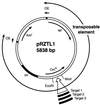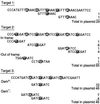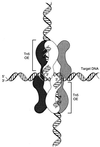Tn5/IS50 target recognition
- PMID: 9724770
- PMCID: PMC27961
- DOI: 10.1073/pnas.95.18.10716
Tn5/IS50 target recognition
Abstract
This communication reports an analysis of Tn5/IS50 target site selection by using an extensive collection of Tn5 and IS50 insertions in two relatively small regions of DNA (less than 1 kb each). For both regions data were collected resulting from in vitro and in vivo transposition events. Since the data sets are consistent and transposase was the only protein present in vitro, this demonstrates that target selection is a property of only transposase. There appear to be two factors governing target selection. A target consensus sequence, which presumably reflects the target selection of individual pairs of Tn5/IS50 bound transposase protomers, was deduced by analyzing all insertion sites. The consensus Tn5/IS50 target site is A-GNTYWRANC-T. However, we observed that independent insertion sites tend to form groups of closely located insertions (clusters), and insertions very often were spaced in a 5-bp periodic fashion. This suggests that Tn5/IS50 target selection is facilitated by more than two transposase protomers binding to the DNA, and, thus, for a site to be a good target, the overlapping neighboring DNA should be a good target, too. Synthetic target sequences were designed and used to test and confirm this model.
Figures





Similar articles
-
IS50-mediated inverse transposition: specificity and precision.Gene. 1985;34(1):17-26. doi: 10.1016/0378-1119(85)90290-2. Gene. 1985. PMID: 2989101
-
Fis plays a role in Tn5 and IS50 transposition.J Bacteriol. 1992 Jul;174(14):4530-7. doi: 10.1128/jb.174.14.4530-4537.1992. J Bacteriol. 1992. PMID: 1320613 Free PMC article.
-
Tn5 insertion specificity is not influenced by IS50 end sequences in target DNA.Mol Gen Genet. 1991 Aug;228(1-2):312-5. doi: 10.1007/BF00282482. Mol Gen Genet. 1991. PMID: 1653404
-
The Tn5 transposon.Annu Rev Microbiol. 1993;47:945-63. doi: 10.1146/annurev.mi.47.100193.004501. Annu Rev Microbiol. 1993. PMID: 7504907 Review.
-
Tn5 as a model for understanding DNA transposition.Mol Microbiol. 2003 Mar;47(5):1199-206. doi: 10.1046/j.1365-2958.2003.03382.x. Mol Microbiol. 2003. PMID: 12603728 Review.
Cited by
-
Highly efficient gene transfer in the mouse gut microbiota is enabled by the Incl2 conjugative plasmid TP114.Commun Biol. 2020 Sep 22;3(1):523. doi: 10.1038/s42003-020-01253-0. Commun Biol. 2020. PMID: 32963323 Free PMC article.
-
Efficient transposon mutagenesis mediated by an IPTG-controlled conditional suicide plasmid.BMC Microbiol. 2018 Oct 24;18(1):158. doi: 10.1186/s12866-018-1319-0. BMC Microbiol. 2018. PMID: 30355324 Free PMC article.
-
A bifunctional DNA binding region in Tn5 transposase.Mol Microbiol. 2008 Feb;67(3):528-40. doi: 10.1111/j.1365-2958.2007.06056.x. Epub 2007 Dec 14. Mol Microbiol. 2008. PMID: 18086215 Free PMC article.
-
Phosphate coordination and movement of DNA in the Tn5 synaptic complex: role of the (R)YREK motif.Nucleic Acids Res. 2008 Oct;36(18):5855-62. doi: 10.1093/nar/gkn577. Epub 2008 Sep 12. Nucleic Acids Res. 2008. PMID: 18790806 Free PMC article.
-
Large-Scale Low-Cost NGS Library Preparation Using a Robust Tn5 Purification and Tagmentation Protocol.G3 (Bethesda). 2018 Jan 4;8(1):79-89. doi: 10.1534/g3.117.300257. G3 (Bethesda). 2018. PMID: 29118030 Free PMC article.
References
-
- Galas D J, Chandler M. In: Mobile DNA. Berg D E, Howe M, editors. Washington, DC: Am. Soc. Microbiol.; 1989. pp. 109–162.
-
- Berg D E. In: Mobile DNA. Berg D E, Howe M M, editors. Washington, DC: Am. Soc. Microbiol.; 1989. pp. 109–162.
-
- Bukhari A I, Zipser D. Nature (London) 1972;236:240–243.
-
- Lichtenstein C, Brenner S. Nature (London) 1982;297:601–603. - PubMed
-
- Klaer R, Kühn S, Tillmann E, Fritz H-J, Starlinger P. Mol Gen Genet. 1981;181:169–175. - PubMed
Publication types
MeSH terms
Substances
Grants and funding
LinkOut - more resources
Full Text Sources
Other Literature Sources

